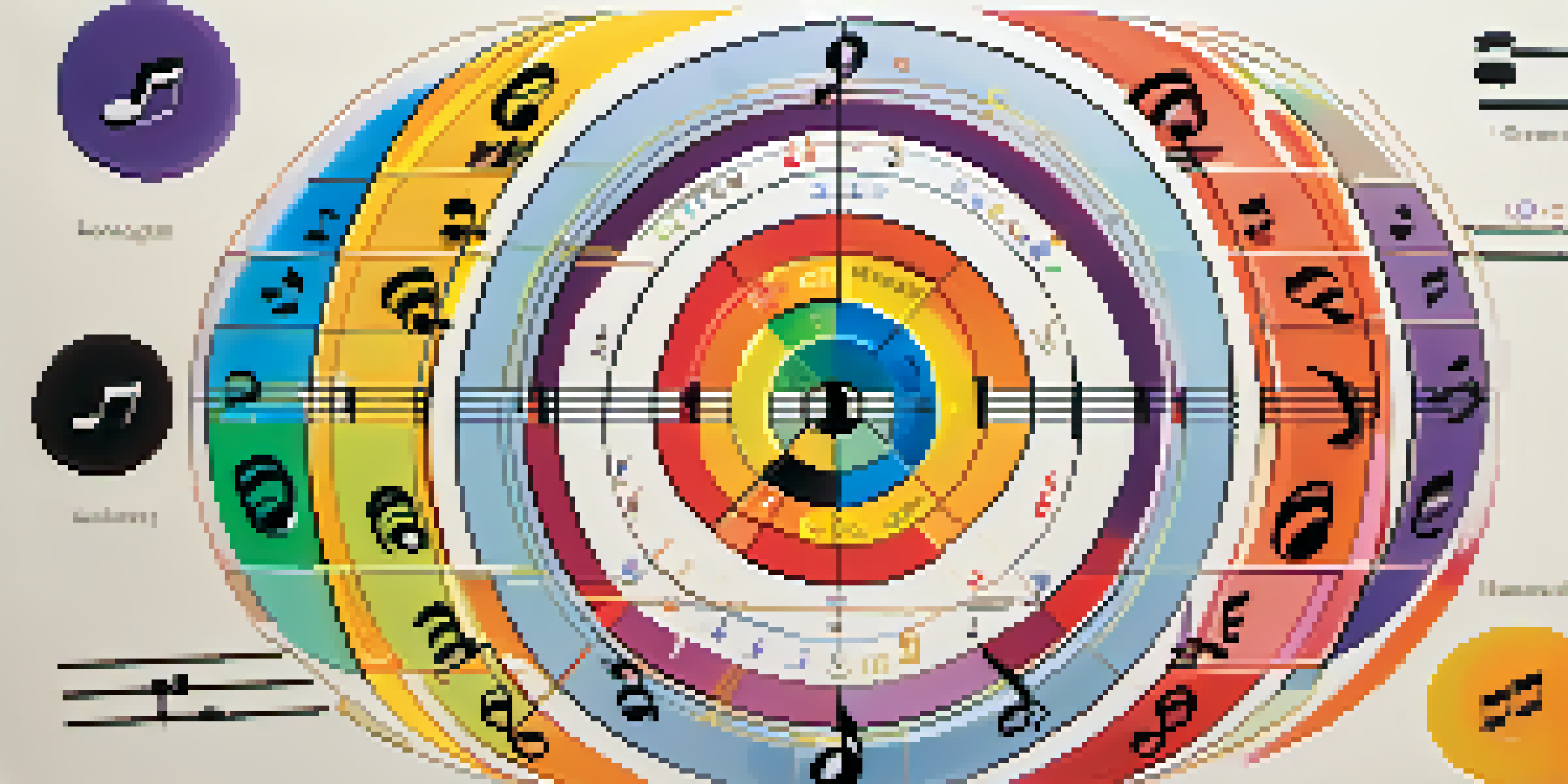Understanding the Circle of Fifths for Guitarists and Composers

What is the Circle of Fifths and Why Does It Matter?
The Circle of Fifths is a visual representation of musical relationships, showing how different keys are connected. Imagine it as a clock where each hour represents a key, and moving clockwise takes you up a perfect fifth. This concept is crucial for guitarists and composers, as it helps you understand key signatures and chord progressions.
Music is the shorthand of emotion.
For example, if you're in the key of C major and you move clockwise to G major, you’re adding an F# to your scale. This understanding can drastically enhance your songwriting by allowing you to transition smoothly between keys. It’s like having a map that guides you through the musical landscape.
By grasping the Circle of Fifths, you'll find it easier to create harmonies and melodies that resonate well together. Whether you're strumming on your guitar or composing a symphony, this tool can elevate your musical creations.
Navigating the Circle: Major and Minor Keys
The Circle of Fifths isn't just for major keys; it also includes minor keys, which are often used in songwriting. Each major key has a relative minor key, positioned three steps counterclockwise. For instance, A minor is the relative minor of C major, and knowing this can help you create a more varied emotional palette in your music.

When transitioning between major and minor keys, the Circle acts as a guide to ensure you're staying in the right harmonic territory. This ability to shift between moods can make a song feel more dynamic and engaging. Think of it as switching gears in a car to adapt to your driving environment.
Understanding Key Relationships
The Circle of Fifths visually represents musical keys and their relationships, aiding musicians in grasping key signatures and chord progressions.
Understanding these relationships allows composers to build tension and resolve it beautifully, adding depth to their pieces. Utilizing the Circle of Fifths, you can effortlessly explore different emotional landscapes in your music.
Building Chord Progressions with the Circle
Chord progressions form the backbone of most songs, and the Circle of Fifths provides a blueprint for crafting them. For instance, moving from the root chord to the fifth chord (like C to G) creates a sense of anticipation and resolution. This natural flow can be applied to various genres, from pop to jazz.
The beautiful thing about learning is that no one can take it away from you.
Consider the classic I-IV-V progression, which is incredibly popular in rock music. By using the Circle, you can easily identify these chords and experiment with their placements to create compelling sequences. It’s like having a recipe that you can tweak to suit your taste.
Additionally, you can explore other progressions by following the Circle, such as ii-V-I, commonly used in jazz. By playing around with these relationships, you'll discover countless combinations that can make your music stand out.
Enhancing Improvisation Skills Using the Circle
Improvisation can be daunting, but the Circle of Fifths simplifies the process. By understanding the relationships between chords, you can navigate through solos more effortlessly. For instance, if you’re jamming in C major, knowing the related chords gives you a solid foundation to build upon.
Think of it as having a safety net while performing; the Circle provides a framework that allows you to explore without losing your way. As you become familiar with the Circle, you’ll find yourself making bolder choices during improvisation, leading to more expressive performances.
Enhancing Songwriting and Improvisation
Utilizing the Circle of Fifths can spark creativity in songwriting and provide a framework for confident improvisation during performances.
This newfound confidence can transform your playing style, making your solos more dynamic and engaging. The Circle of Fifths becomes your musical compass, guiding you through the improvisational landscape.
Using the Circle for Songwriting Inspiration
Struggling with writer's block? The Circle of Fifths can serve as a wellspring of inspiration. By exploring the relationships between keys and chords, you might stumble upon unexpected combinations that spark creativity. It’s like discovering a hidden path on a hike that leads to a beautiful view.
Try picking a key and then moving around the Circle to see what chords resonate with you. This exploration can lead to unique progressions and melodies that you might not have considered otherwise. Each shift in the Circle can open new doors for your musical ideas.
Many famous songs have been written using the Circle, showcasing its effectiveness as a songwriting tool. By incorporating it into your creative process, you'll likely find that the ideas flow more freely.
The Role of the Circle in Music Theory
The Circle of Fifths isn't just a handy tool; it’s also a cornerstone of music theory. It helps musicians understand the fundamentals of key signatures, scales, and harmony. By grasping these concepts, you’ll gain a deeper appreciation of the music you play and hear.
For example, each key has a specific number of sharps or flats, which can be easily visualized using the Circle. This knowledge helps you read sheet music more effectively and aids in transposing songs into different keys. It’s like learning the rules of a game; once you understand them, you can play with confidence.
Understanding Key Relationships
The Circle of Fifths visually represents musical keys and their relationships, helping musicians navigate key signatures and chord progressions.
By mastering the Circle, you’ll be better equipped to analyze and create music, allowing you to express yourself more fully. This foundational knowledge can propel you to new heights in your musical journey.
Practical Exercises to Master the Circle of Fifths
To truly internalize the Circle of Fifths, hands-on practice is essential. Start by playing through the major and minor keys on your instrument, focusing on the corresponding chords. This exercise will help you visualize the Circle while reinforcing key signatures and relationships.
Another effective exercise is to write short pieces using the Circle as your guide. Challenge yourself to create a melody or chord progression that moves around the Circle. This practice not only hones your skills but also encourages you to think creatively.

Consider collaborating with fellow musicians using the Circle as a framework for your jam sessions. This collaborative effort can lead to exciting discoveries and strengthen your understanding of the Circle. The more you engage with it, the more naturally it will come to you.